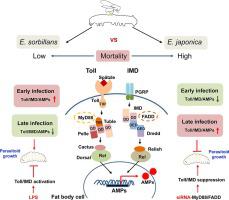Journal of Insect Physiology ( IF 2.3 ) Pub Date : 2024-01-23 , DOI: 10.1016/j.jinsphys.2024.104614 Jin Yang 1 , Qian Xu 2 , Wenwen Shen 3 , Zhe Jiang 2 , Xinran Gu 2 , Fanchi Li 1 , Bing Li 1 , Jing Wei 4

|
Parasitoids have utilized a variety of strategies to counteract host defense. They are in different taxonomic status and exhibit phenotypic and genetic diversity, and thus are thought to evolve distinct anti-defense mechanisms. In this study, we investigated the performance of two closely related parasitoids, Exorista japonica and Exorista sorbillans (Diptera: Tachinidae) that are biological control agents in agriculture and major insect pests in sericulture, on the host Bombyx mori. We show that the host is more susceptible to E. sorbillans infection while relatively resistant to E. japonica infection. Moreover, the expression levels of host antimicrobial peptides (AMPs) genes are repressed at early infection and induced at late infection of E. japonica, while AMPs are over-expressed at early infection and return to normal levels at late infection of E. sorbillans. In parallel, Toll and IMD pathway genes are generally induced at late infection of E. japonica, whereas these genes are up-regulated at early infection and down-regulated at late infection of E. sorbillans. Activating of host Toll/IMD pathways and AMPs expression by lipopolysaccharide (LPS) represses the larval growth of E. sorbillans. Conversely, inhibiting host Toll/IMD pathways by RNA interference significantly promotes E. japonica development. Therefore, the Toll/IMD pathways are required in the host for defense against infection of dipteran parasitoids. Overall, our study provides the new insight into the diversified host-parasitoid interactions, and offers a theoretical basis for further studies of the adaptive mechanism of dipteran parasitoids.
中文翻译:

Toll/IMD 途径介导宿主针对双翅类寄生蜂的保护
拟寄生物利用多种策略来对抗宿主防御。它们处于不同的分类地位并表现出表型和遗传多样性,因此被认为进化出不同的反防御机制。在本研究中,我们研究了两种密切相关的寄生蜂,即日本驱寄虫和山梨驱寄虫(双翅目:寄蝇科),它们是农业中的生物防治剂和蚕桑业中的主要害虫,在宿主家蚕上的表现。我们发现宿主更容易受到山梨麻痹症感染,而对日本麻痹症感染相对有抵抗力。此外,宿主抗菌肽(AMPs)基因的表达水平在日本麻仁感染早期被抑制,在感染晚期被诱导,而AMPs在感染早期过度表达,在感染晚期恢复到正常水平。同时,Toll 和 IMD 途径基因通常在E. japonica感染后期被诱导,而这些基因在E. sorbillans感染早期上调,而在感染后期下调。脂多糖 (LPS) 激活宿主 Toll/IMD 途径和 AMP 表达,抑制索美兰幼虫的生长。相反,通过 RNA 干扰抑制宿主 Toll/IMD 途径可显着促进E. japonica的发育。因此,宿主需要Toll/IMD途径来防御双翅类寄生蜂的感染。 总体而言,我们的研究为多样化的寄主与寄生蜂相互作用提供了新的见解,并为进一步研究双翅目寄生蜂的适应机制提供了理论基础。


















































 京公网安备 11010802027423号
京公网安备 11010802027423号